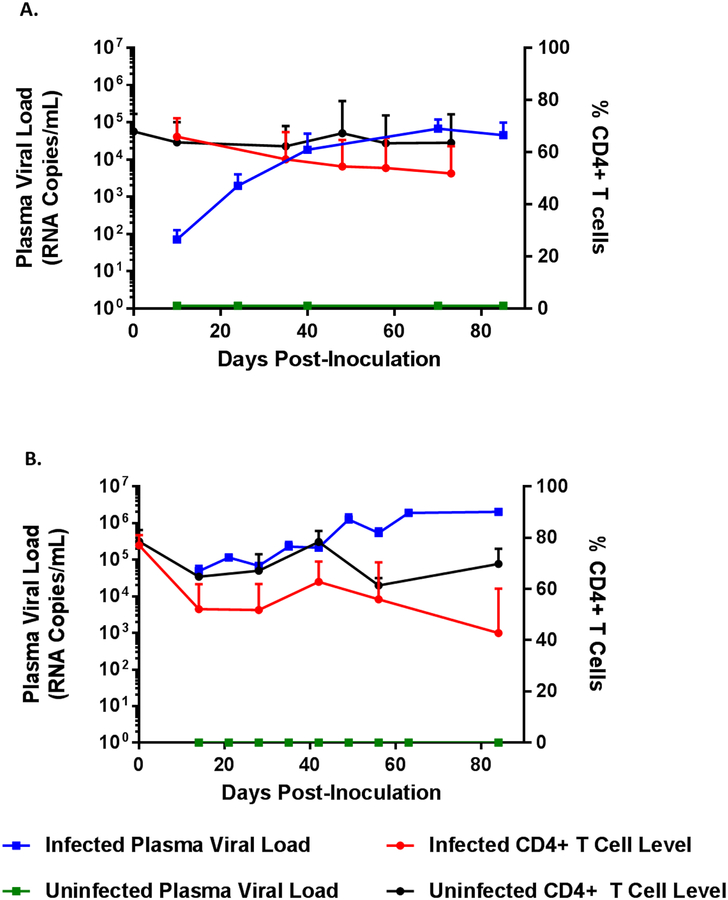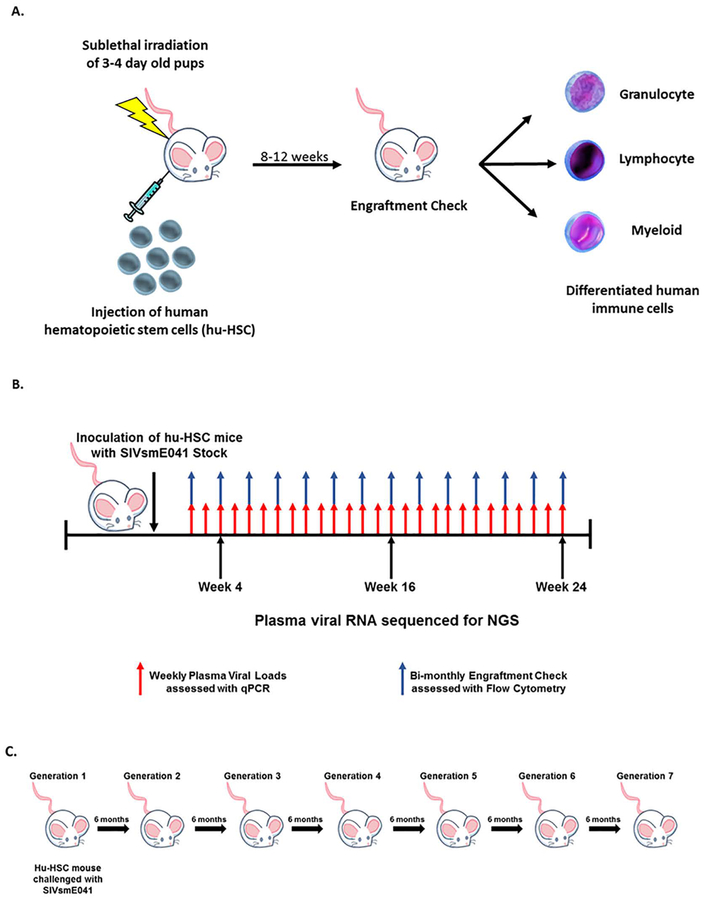Abstract
How SIV progenitors evolved into deadly HIV-1 and HIV-2 following initial cross-species transmission still remains a mystery. Here we used humanized mice as a human surrogate system to evaluate SIVsm evolution into HIV-2. Increased viral virulence to human CD4+ T cells and adaptive genetic changes were observed during serial passages.
INTRODUCTION
Thirteen independent SIV cross-species transmission events have led to epidemic HIV strains through the accumulation of adaptive mutations in SIV resulting in global pandemics/epidemics by HIV-1 and HIV-2.1 However, data is lacking on how the adaptive changes occurred in these progenitor SIVs due to the lack of suitable experimental system.
In order to evaluate this, we used a human surrogate model of hu-HSC humanized mice transplanted with human hematopoietic stem cells to elucidate the adaptation of SIVsm into HIV-2 in vivo.2–6 These mice harbor human T cells, B cells, monocytes/macrophages and DC cells3, 6–8 and are highly susceptible to HIV infection.2, 7, 9–12 To determine if SIVsm could cross the species barrier, we used primary SIVsm isolate E041 to infect hu-HSC mice followed by its sequential passage for seven generations. Mice were assessed for plasma viral loads and CD4+ T cell decline. Viral isolates from different passages were assessed by next-generation sequencing to determine genetic changes.
RESULTS
Following the initial challenge with SIVsmE041, hu-mice showed detectable viremia within 2 weeks. The viremia levels gradually increased by three logs peaking at 6.69× 104 copies/ml at 10 weeks post-inoculation (Figure 2A). Virus from this first passage was then subsequently passaged six more times in hu-HSC mice to mimic the evolution of SIVsm into HIV-2. By the seventh generation, viral loads were found to be 2.5-logs higher at 2 weeks post-inoculation compared to that of initial first passage indicating an increase in viral fitness (Figure 2B) to human cell infection.
Figure 2.
Kinetics of SIVsmE041 infection and CD4+ T‐cell decline during in vivo passages in hu‐HSC mice. A, First‐ and (B) seventh‐generation plasma viral loads and CD4+ T‐cell decline seen in SIVsmE041‐infected and SIVsmE041‐uninfected hu‐HSC mice. Statistically significant CD4+ T‐cell depletion was seen in both the first‐ and seventh‐generation infected mice relative to the uninfected mice (two‐tailed Student’s t test, P ˂ 0.05)
One of the hallmarks of HIV infection is the depletion of CD4+ T cells. There was no significant human CD4+ T cell decline during the initial few weeks of infection with SIVsmE041. However, a gradual decline is noted during subsequent weeks relative to the uninfected controls (Figure 2A). By comparison, during the seventh passage, SIVsm displayed a more rapid, statistically significant (p < 0.05) CD4+ T cell decline by day 10 (Figure 2B), suggesting an increased pathogenicity of the serially passaged seventh generation viral strain.
DISCUSSION
Many theories exist regarding the origin and transmission of HIV pathogens in the human population. Compelling genomic evidence suggests that HIV-2 arose through cross-species transmission events from sooty mangabeys.1 Viral adaptive changes needed for this successful cross-species evolution are not well understood due to the lack of an ideal in vivo system for experimental evaluation. In this study, we used a hu-HSC mouse model to test this hypothesis. Our results showed that SIVsm can readily infect hu-mice and give rise to chronic viremia consistent with HIV-2 infection in humans. Increased viral fitness to human cells as evidenced by the higher viral loads observed by the seventh generation resulting in a more rapid CD4+ T cell decline suggests selection and evolution of the progenitor SIVsm in vivo. This is consistent with the hypothesis that SIVsm evolved gradually during sequential infections in the human host to become more pathogenic.1 At the genomic level, we previously identified 14 nonsynonymous substitutions in gag, vif, vpr, rev, env and nef that became fixed in the human adapted viral population. This was observed in multiple mice across five passages/generations.13 These substitutions are likely indicative of increased viral fitness to the human host. Studies are currently underway to elucidate if these nonsynonymous substitutions indeed determine cross-species transmissibility.
MATERIALS AND METHODS
Generation of humanized mice
Humanized mice were generated as previously described (Figure 1A).13–17 Mice were maintained at the Colorado State University Painter Animal Center. The studies conducted in this publication have been reviewed and approved by the CSU Institutional Animal Center and Use Committee.
Figure 1.
Hu‐HSC mice generation and experimental scheme with SIVsmE041 progenitor virus. A, Neonatal mice were sublethally irradiated and injected intrahepatically with human CD34+ hematopoietic stem cells. Mice are screened 8‐12 wk post‐reconstitution for human immune cell engraftment. B, Schematic representation of SIVsmE041 infection. C, Serial passaging methodology in hu‐HSC mice
SIVsmE041 Infection of humanized mice
The SIVsmE041 (Genbank accession HM059825.1) used in this study was obtained from a 21 year old sooty mangabey euthanized for displaying clinical signs of AIDS18–22 and then propagated in sooty mangabey PBMC creating a true primary isolate comprised of a population of closely related viruses.
Plasma viral load and CD4+ T cell level determination
Five hu-HSC mice were injected intraperitoneally (i/p) with 200 μl of SIVsmE041 (TCID50 811). Peripheral blood was collected by tail vein puncture weekly for viral loads and bimonthly for engraftment (Figure 1B). Viral RNA was extracted using the E.Z.N.A. Viral RNA kit (Omega bio-tek) and viral loads determined using the iScript One-Step RT-PCR kit with SYBR Green and the manufacturer’s instructions (Bio Rad) as described previously.13 Whole blood was stained using fluorophores conjugated to mouse anti-human CD45-FitC (eBioscience), CD3-PE (eBioscience) and CD4-PE/Cy5 (BD Pharmingen) and assessed using the BD Accuri C65 FACS Analyzer as described previously.13 CD4+ T cell levels were calculated within the CD45+CD3+ double positive population and decline was assessed using a two-tailed Student’s t-test (p<0.05).
Preparation of SIVsmE041 for sequential passaging
At the end of each generation (Figure 1C), SIVsm infected mice with the highest titer were euthanized and various tissues such as the spleen, bone marrow, lymph nodes and whole blood were harvested and used to propagate virus as previously described.13 For each subsequent generation, five hu-HSC mice were injected with 200 μl of viral supernatant.
ACKNOWLEDGEMENTS
Work reported here was supported by NIH, USA grant R01 AI12334 to R. A. as well as the National Center for Research Resources and the Office of Research Infrastructure Programs (ORIP) of the NIH through grant OD011104 at the Tulane National Primate Research Center.
REFERENCES
- 1.Marx PA, Alcabes PG, Drucker E. Serial human passage of simian immunodeficiency virus by unsterile injections and the emergence of epidemic human immunodeficiency virus in Africa. Philos Trans R Soc Lond B Biol Sci 2001,356:911–920. [DOI] [PMC free article] [PubMed] [Google Scholar]
- 2.Akkina R New generation humanized mice for virus research: comparative aspects and future prospects. Virology 2013,435:14–28. [DOI] [PMC free article] [PubMed] [Google Scholar]
- 3.Akkina R Human immune responses and potential for vaccine assessment in humanized mice. Curr Opin Immunol 2013,25:403–409. [DOI] [PMC free article] [PubMed] [Google Scholar]
- 4.Lan P, Tonomura N, Shimizu A, Wang S, Yang YG. Reconstitution of a functional human immune system in immunodeficient mice through combined human fetal thymus/liver and CD34+ cell transplantation. Blood 2006,108:487–492. [DOI] [PubMed] [Google Scholar]
- 5.Shultz LD, Brehm MA, Garcia-Martinez JV, Greiner DL. Humanized mice for immune system investigation: progress, promise and challenges. Nat Rev Immunol 2012,12:786–798. [DOI] [PMC free article] [PubMed] [Google Scholar]
- 6.Ito R, Takahashi T, Katano I, Ito M. Current advances in humanized mouse models. Cell Mol Immunol 2012,9:208–214. [DOI] [PMC free article] [PubMed] [Google Scholar]
- 7.Garcia S, Freitas AA. Humanized mice: current states and perspectives. Immunol Lett 2012,146:1–7. [DOI] [PubMed] [Google Scholar]
- 8.Melkus MW, Estes JD, Padgett-Thomas A, Gatlin J, Denton PW, Othieno FA, et al. Humanized mice mount specific adaptive and innate immune responses to EBV and TSST-1. Nat Med 2006,12:1316–1322. [DOI] [PubMed] [Google Scholar]
- 9.Denton PW, Garcia JV. Humanized mouse models of HIV infection. AIDS Rev 2011,13:135–148. [PMC free article] [PubMed] [Google Scholar]
- 10.Charlins P, Schmitt K, Remling-Mulder L, Hogan LE, Hanhauser E, Hobbs KS, et al. A humanized mouse-based HIV-1 viral outgrowth assay with higher sensitivity than in vitro qVOA in detecting latently infected cells from individuals on ART with undetectable viral loads. Virology 2017,507:135–139. [DOI] [PMC free article] [PubMed] [Google Scholar]
- 11.Choudhary SK, Archin NM, Cheema M, Dahl NP, Garcia JV, Margolis DM. Latent HIV-1 infection of resting CD4(+) T cells in the humanized Rag2(−)/(−) gammac(−)/(−) mouse. J Virol 2012,86:114–120. [DOI] [PMC free article] [PubMed] [Google Scholar]
- 12.Neff CP, Ndolo T, Tandon A, Habu Y, Akkina R. Oral pre-exposure prophylaxis by anti-retrovirals raltegravir and maraviroc protects against HIV-1 vaginal transmission in a humanized mouse model. PLoS One 2010,5:e15257. [DOI] [PMC free article] [PubMed] [Google Scholar]
- 13.Schmitt K, Mohan Kumar D, Curlin J, Remling-Mulder L, Stenglein M, O’Connor S, et al. Modeling the evolution of SIV sooty mangabey progenitor virus towards HIV-2 using humanized mice. Virology 2017,510:175–184. [DOI] [PMC free article] [PubMed] [Google Scholar]
- 14.Akkina RK, Rosenblatt JD, Campbell AG, Chen IS, Zack JA. Modeling human lymphoid precursor cell gene therapy in the SCID-hu mouse. Blood 1994,84:1393–1398. [PubMed] [Google Scholar]
- 15.Bai J, Gorantla S, Banda N, Cagnon L, Rossi J, Akkina R. Characterization of anti-CCR5 ribozyme-transduced CD34+ hematopoietic progenitor cells in vitro and in a SCID-hu mouse model in vivo. Mol Ther 2000,1:244–254. [DOI] [PubMed] [Google Scholar]
- 16.Veselinovic M, Charlins P, Akkina R. Modeling HIV-1 Mucosal Transmission and Prevention in Humanized Mice. Methods Mol Biol 2016,1354:203–220. [DOI] [PubMed] [Google Scholar]
- 17.Berges BK, Akkina SR, Folkvord JM, Connick E, Akkina R. Mucosal transmission of R5 and X4 tropic HIV-1 via vaginal and rectal routes in humanized Rag2−/− gammac −/− (RAG-hu) mice. Virology 2008,373:342–351. [DOI] [PMC free article] [PubMed] [Google Scholar]
- 18.Gormus BJ, Xu K, Baskin GB, Martin LN, Bohm RP, Blanchard JL, et al. Experimental leprosy in monkeys. I. Sooty mangabey monkeys: transmission, susceptibility, clinical and pathological findings. Lepr Rev 1995,66:96–104. [DOI] [PubMed] [Google Scholar]
- 19.Gormus BJ, Xu K, Cho SN, Baskin GB, Bohm RP, Martin LN, et al. Experimental leprosy in monkeys. II. Longitudinal serological observations in sooty mangabey monkeys. Lepr Rev 1995,66:105–125. [DOI] [PubMed] [Google Scholar]
- 20.Fultz PN, McClure HM, Anderson DC, Swenson RB, Anand R, Srinivasan A. Isolation of a T-lymphotropic retrovirus from naturally infected sooty mangabey monkeys (Cercocebus atys). Proc Natl Acad Sci U S A 1986,83:5286–5290. [DOI] [PMC free article] [PubMed] [Google Scholar]
- 21.Ling B, Apetrei C, Pandrea I, Veazey RS, Lackner AA, Gormus B, et al. Classic AIDS in a sooty mangabey after an 18-year natural infection. J Virol 2004,78:8902–8908. [DOI] [PMC free article] [PubMed] [Google Scholar]
- 22.Murphey-Corb M, Martin LN, Rangan SR, Baskin GB, Gormus BJ, Wolf RH, et al. Isolation of an HTLV-III-related retrovirus from macaques with simian AIDS and its possible origin in asymptomatic mangabeys. Nature 1986,321:435–437. [DOI] [PubMed] [Google Scholar]




